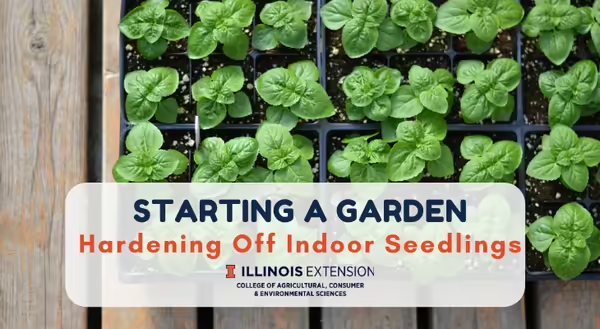
Much like humans after being cooped up all winter, plants require acclimation to the outdoors prior to being transplanted outside; for plants this is termed hardening off. Hardening off is the process of slowly introducing plants to outdoor conditions after being started indoors.
Growing conditions inside your home or a greenhouse are quite different than that outdoors. Transplants require time to adjust to this change, so they aren’t damaged or killed. When transferred outdoors, plants experience wind, colder temperatures, more direct sunlight, and fluctuations of precipitation. If transferred too quickly, plants can become lodged or drowned. Plant stems can snap due to strong winds, or leaves can become sunburned from being exposed to direct sunlight.
The goal of hardening off is to slowly expose the plants to the elements of the outdoors to strengthen the plants. Hardening off reduces the growth rate and thickens the cuticle and waxy layers. It also stimulates root development, increases the amount of carbohydrates in tissues for food reserves, reduces the amount of freeze prone water in cells, and develops lignin in the cell walls.
About 2 weeks prior to transplanting plants outside, it is recommended to start the hardening off process. Start by placing plants outside during the warmer part of the day (typically between 12-5 PM) for about 2-3 hours; gradually increasing the amount of time each day. After working the plants up to being outside for 10-12 hours a day for a few days, leave the plants outside for 24 hours for a couple days. Once you complete this, your plants are ready for transplanting. During this period of hardening off, gradually reduce how often you water; however, don’t allow the plants to wilt. It is also not recommended to fertilize the plants before or during the hardening off period.
Hardening off differs for plants, so it is important to know the hardiness of your plants. Cool season crops such as broccoli, cabbage, cauliflower, and lettuce are well adapted to grow in cooler weather making them hardier and more capable of being transplanted outside sooner. Learn more about cool season crops and when to transplant them outside in our blog post. As the name suggests, warm season crops such as tomatoes, peppers, zucchini, and cucumber prefer warmer weather and are less cold hardy than cool season crops; these are the plants that hardening off is most important for. Warm season crops should not be transplanted outside until after the last frost for your area. For more information on warm season vegetables, visit our blog post.
Want to get notified when new Good Growing posts are available? SIGN UP HERE!